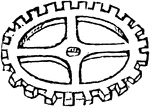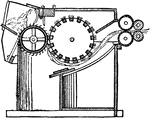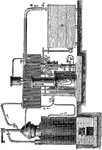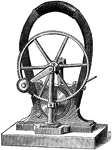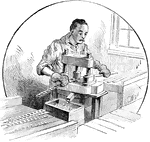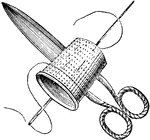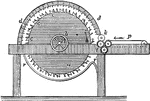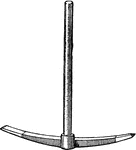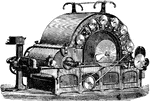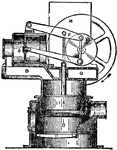
Stuffing-box
"A small enclosure, to prevent the escape of steam, etc., at a joint in machinery. — Williams,…
Improvised trowel
"A very good trowel may also be made from a discarded blade of a mowing-machine, and it answers the…

Wimshurst Electric Machine
"The essential parts of an ordinary Wimshurst machine, are two ordinary drums. On each plate are fixed…
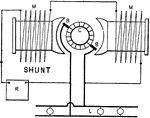
Shunt dynamo
"The shunt wound dynamo differes from the series wound machine, in that an independent circuit is used…
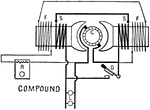
Compound wound dynamo
"Compound wound dynamo, used when better automatic regulation of voltage on constant pressure circuits…

Solid core disk
"The metal cut away near the center reduces the weight and provides passages for air circulation." —…

Compositor
"The art of printing from movable types is of comparatively modern origin, only four hundred years having…
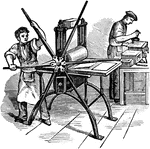
Copper-Plate Printing
"In all engraving upon metal plates the traces or marks which are to appear on the paper are cut or…

Nail forge
"Formerly, all nails were hand made, by forging on an anvil; and vast quantities are still made in this…

Paint Mixing Machine
For mixing paints, pastes, calcimine, fillers, enamels and lead and oil paint. Made in two sizes- 5…
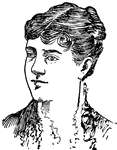
Adelina Patti
One of the most highly regarded opera singers of the 19th century. Giuseppe Verdi was not alone in calling…

Steam Engine
A machine for utilizing the elastic force of steam as a motive power, and now constructed in a variety…
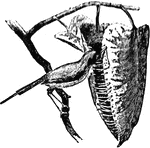
Tailorbird
A genus of birds of the warbler family, and so named from their habit of sewing leaves of cotton or…

Typewriter
A machine for producing printed characters as a substitute for writing, and now employed very extensively…

Windmill
A machine turned by the wind and designed to furnish motive power, as for pumping or for operating mills.…

Ancient Egyptian Music
This image shows a group of ancient egyptian street musicians. (1) Woman with a tall light harp with…

Road Oiler
This illustration shows a machine used to put oil on roads during its construction, in the nineteenth…
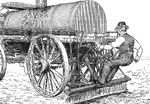
Road Oiler
This illustration shows a machine used to put oil on roads during its construction, in the nineteenth…
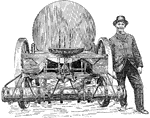
Road Oiler
This illustration shows a machine used to put oil on roads during its construction, in the nineteenth…

Dredge
Dredging, the excavating or scooping out of soil, mud, sand or rock under water by a machine called…
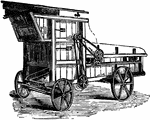
Portable Threshing-Machine
A machine invented by Andrew Meikle to seperate grain from stalks and husks.
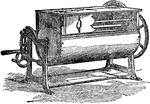
Kneading Machine
"A form of dough-making machine in common use. It consists of a trough or box, the lower portion of…

Kneading Machine
"A kneading-machine of a highly approved form, used in the great Scipion bakery of Paris, the invention…
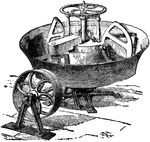
Kneading Machine
"The trough is a castiron basin, which turns on a vertical axis. The interior is provided with a kneader,…
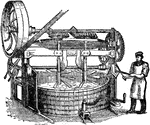
Vertical Mixer
"This machine consists of two vertical shafts, carrying radial arms. These arms pass each other in opposite…
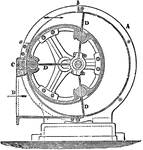
Blowing-Machine
"An American machine, introduced into England by Mr. Ellis. It consists of an iron cylindrical casing…

Coal-cutting Machine
"This machine consists essentially of a horizontal piston and cylinder engine fixed upon a platform…

Slubbing Frame
"The operation which succeeds that of the drawing frame is slubbing, where the sliver has a certain…

The Mule
"Probably no inventive contribution has been offered to the cotton trade more important than the mule.…

Mule
"In 1818 William Eator obtained a patent for a self-acting mule, in which the operations ordinarily…

Pulp Engine
A machine used for converting paper rags, esparto, and other materials into pulp with water.

Single Acting Pump
A hydraulic machine used for raising liquids from a lower level to a higher level through a pipe or…

Stirling's Air Engine
"A form of air-engine which was invented in 1816 by the Rev. R. Stirling is of special interest as embodying…

Hot-wire Ammeter
"Hot-wire instruments working on the sag principle can be used in any position if properly contructed,…

Automatic Oil Muffle Furnace
"A muffle furnace, employed for annealing, hardening, and tempering." —Encyclopedia Britannica,…
